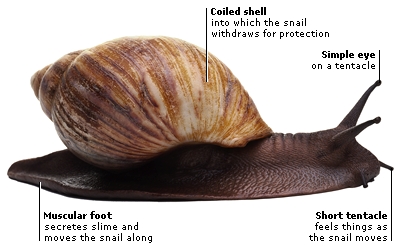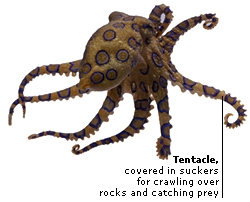Slugs, snails, oysters, clams, squid, octopuses, and cuttlefish are very different to look at, but they are all molluscs. They have a ribbon-like tongue, called the radula, covered in thousands of denticles (tiny teeth). Many have a calcium-carbonate shell. Most molluscs live in water, but slugs and snails live on land.

The African land snail can be 30 cm (12 in) long. Like all snails, it carries a coiled shell on its back and withdraws into the shell when threatened. It moves slowly on a large, muscular foot, using slime to ease the way. Its mouth, underneath its head, contains the denticle-covered radula.

The blue-ringed octopus is a mollusc that does not have a shell. It has a large brain and big eyes. It uses its eight arms to crawl, but also squirts water from inside its body to move more quickly.
PHYLUM: MOLLUSCA
Class: Bivalvia
Features: shell in two symmetrical halves with hinge
Class: Polyplacophora
Features: shell made up of several overlapping plates
Class: Gastropoda
Features: suction foot, many have spiral shell

Class: Scaphopoda
Features: long, tubular shells, burrow into sediment
Class: Cephalopoda
Features: tentacles, suckers







0 comments:
Post a Comment